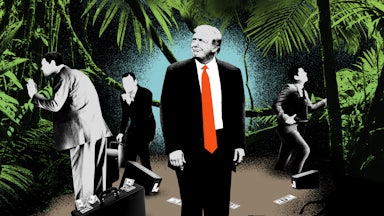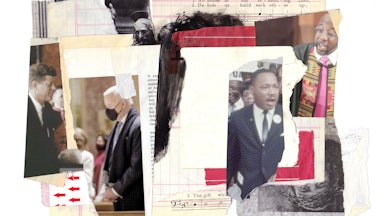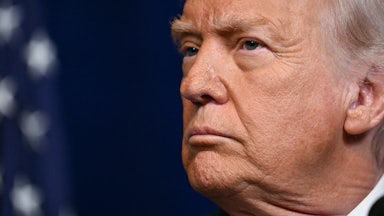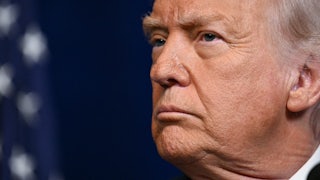No one wants to talk about the business of religion. But it’s time we do. On January 4, the Poway, California Rabbi Yisroel Goldstein was sentenced to fourteen months in prison, for having received at least $6.2 million in fake contributions to his synagogue and affiliated charities and secretly refunding up to 90 percent of the donations to the “donors.”* Those donors, in turn, used the counterfeit receipts to illegally claim huge tax deductions for their nonexistent donations; Goldstein skimmed about 10 percent of the take—more than half a million dollars—for himself. It was a tidy bit of graft: using the synagogue as a platform to funnel money, defrauding Fortune 500 companies by tricking them into matching fake donations, and using false information and invoices to be eligible for emergency funds and private loans.
The case received widespread attention because Goldstein’s synagogue was the target of an antisemitic shooting in April 2019; he himself lost fingers in the incident, catapulting him as a national hero. But while Goldstein may be a unique grifter—the perfect protagonist for a truth-is-stranger-than-fiction caper—his crimes are hardly novel. And neither are the means by which Goldstein facilitated his buckraking: The special taxation exemptions that houses of worship enjoy, and which ostensibly exist to protect parishioners, have been weaponized by scammers to harm their interests.
Houses of worship being used as stages for financial fraud is in no way a new phenomenon in the United States. Every so often, reports of a new scandal emerge, some of which are rather sensational. In 2007, a pastor in Darien, Connecticut, was arrested for stealing $1.3 million from his church—using it to shop at luxury department stores, buy Cartier jewelry, and drive a Jaguar. In 2018, two California nuns embezzled $500,000 from Catholic school tuition and other funds to bankroll a gambling trip to Las Vegas. Emergency funding from the government, such as PPP loans, has also been a soft target of late: Last year, a Washington, D.C., pastor used millions of dollars obtained from fraudulent PPP loans to buy luxury cars; just this week, a Charlotte, N.C., pastor was sentenced for using fraudulent information to obtain a Covid-19 relief loan.
These reports are only the tip of the iceberg. Fraud, while unfortunately rampant, goes largely unreported in religious communities—as much as 95 percent of it, according to one report—thanks to both the secrecy around finances and the pressures that whistleblowers face to stay silent. A 2007 study by Villanova University found that a shocking 85 percent of Catholic dioceses were victimized by embezzlement; a decade later, a LifeWay Research survey of over 1,000 churches found that one in 10 Protestant churches have self-reported experiencing embezzlement.
The issue is systemic and may be a uniquely American problem: In the U.S., houses of worship have effectively no public oversight of their finances, while enjoying massive tax benefits. As long as churches, synagogues, and mosques are the only nonprofits exempt from filing 990s and thus reporting their finances to the public, houses of God will continue to be black holes for charitable donations and magnets for fraudsters.
“Because of their opacity and the unique nature of religious authority, churches are more likely to foster and shelter malfeasance,” tax lawyer John Montague wrote in The Cardozo Law Review in 2013. And while some houses of worship admirably choose to implement public accountability measures, others take advantage of the government’s willingness to turn a blind eye, often relying on “magnetic personalities who control the purse strings and exercise tremendous sway over congregants.” Religion annually contributes about $1.2 trillion of socioeconomic value to the U.S. economy—and with the projected rate of mismanagement and embezzlement in churches today, there are millions of charitable dollars disappearing behind American altars every year.
Since the Tax Reform Act of 1969, in which churches were exempted from having to file public information returns—“in view of the traditional separation of church and state”—there have been various attempts to legislate accountability, spurred by explosive scandals of financial abuses of power by televangelists.
But measures aimed at curbing these abuses have failed to pass, and the exemption remained intact. Its survival was not due to any policy considerations, nor because of a conflict with the separation of church and state (given that other religious organizations do have to file these returns and that houses of worship are subject to other federal requirements, mandated reporting would not pose a constitutional conflict). Rather, it was because elected representatives did not want to take the political risk of supporting anything that could be perceived as anti-religion. It was due to this political will to protect churches from scrutiny that, in 1986, Congress added IRC Sec. 7611 to the tax code, adding several further conditions for an IRS investigation of a house of worship, thus perpetuating that opacity.
Yet anyone who truly cares about the future of American religion should be advocating for transparency in our temples. As a religion journalist and as a young rabbi’s wife, I’ve seen the consequences of secrecy around religious financing firsthand in countless communities. And perhaps what is most tragic is to witness innocent believers serving as the perfect victims for this fraud.
“No one would think that a priest would embezzle, and no one would think that a church worker would, so they don’t put in the kinds of internal controls common in the business world,” Charles Zech, a professor of economics and expert in church management, told The Milwaukee Sentinel in 2007, after the local Catholic diocese decided to require further audits of its parish. Clergy and administrators who balk at information requests tend to have a personal motivation to do so—and as long as there is no government oversight, they can easily provide falsified reports if put under pressure by congregants. Often the power structures inside houses of worship, and the nature of religious authorities who demand total submission or loyalty, can make it impossible for parishioners to seek transparency.
In extreme cases, financial opacity in houses of worship can even become a security risk: It was that exact lack of transparency that may have cost human life at Goldstein’s synagogue in Poway. Though the synagogue had received $150,000 from the government because it “believed that it was at risk of an anti-Semitic attack on its congregants,” according to one of the congregants’ subsequent suits—court documents show that on the day of the attack, the building’s doors were unlocked and no guards, gates, or other security measures were in place. Instead of providing a necessary guard at the front of the synagogue, funds had allegedly been diverted elsewhere; the plaintiffs argue that this mistake may have cost the life of Lori Gilbert-Kaye, who was killed in the shooting.
It doesn’t have to be this way. Financial opacity for religious institutions should not just be a concern for anti-corruption warriors, or for secular Americans who revel at the chance to depict religious leaders as greedy villains. The call for accountability ought to be coming not from liberal social justice warriors but from the pious, from those who care most about trust, honesty, and America’s emptying pews. Because it may be that this lack of public oversight affects the reputation of faith altogether, threatening the future of organized worship.
Recent studies show that not only is U.S. church attendance at an all-time low—but that the majority of millennials take the impact of their donations seriously, valuing transparency perhaps more than their elders. Let us consider the correlation between the two. Over the years, I’ve heard countless times from members of various communities expressing doubt about institutions’ governance. “I don’t want to give them another dollar,” they would whisper to me after they discovered a red flag. And when congregants discover something egregious, they begin questioning religion itself: How can that person preach morality when they represent the direct opposite? How am I supposed to find this person inspiring when he is secretly using church coffers to enrich himself illegally? These instances can cause lifelong damage to congregants’ faith and turn them off building meaningful lives in spiritual communities.
There is plenty of handwringing over dwindling attendance in American houses of worship. But it is neither Covid-19 nor some terrible hedonism or atheism that is keeping people away. More often than not, it is hypocrisy that distances young people from the sanctuaries.
If religious leaders care about staying relevant in the long-term, and not just powerful in the fleeting here and now, they ought to be heeding the biblical call for honesty. And as long as our elected officials abdicate their responsibility in keeping religious community members safe from abuse, it is in the hands of the people—those sitting in the pews, dropping their proverbial coins into the alms boxes—to demand transparency and to ensure that their holy places are just that: clean, truthful, untainted. The future of American religion may depend on this.
*This article originally misstated Goldstein’s arrest and sentencing dates.










